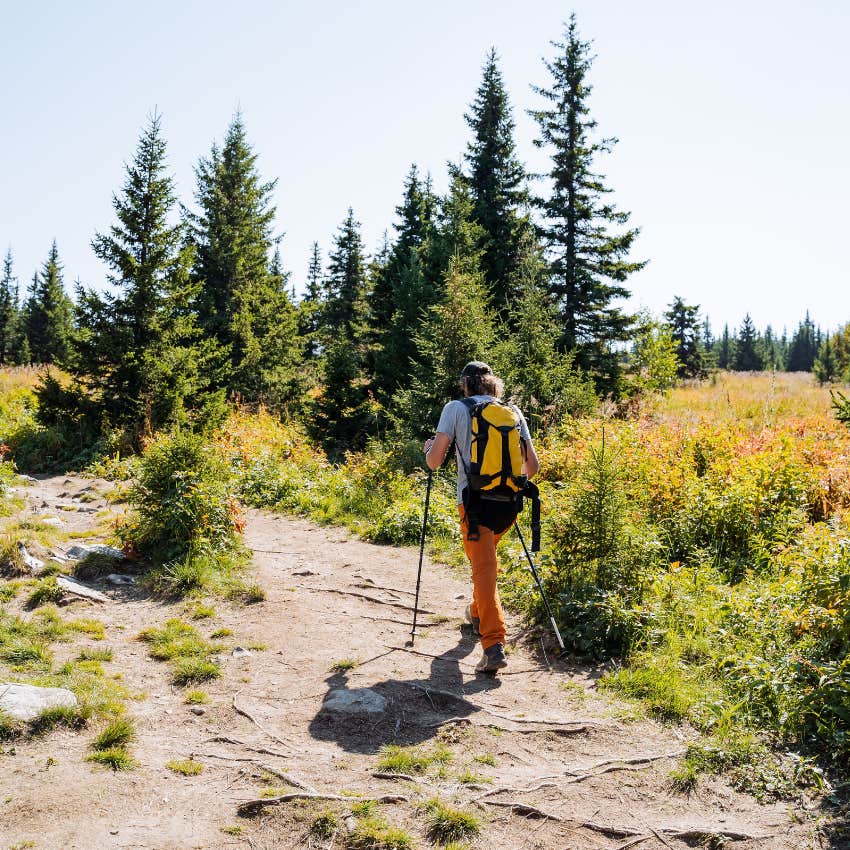This Weird Walking Trick Might Be The Health Boost You Need, Says Longevity Doctor
How walking through rough terrain helps rebuild your balance and cognitive function.
 MixMedia | Canva
MixMedia | Canva Most people walk to relax. I came to Borneo to let the ground fight back. This morning, outside Kota Kinabalu, Malaysia, my boots slipped on a tangle of wet roots.
The air smelled of earth and rain. A quiet hum of life surrounded me. In that awkward, humbling stumble, I felt something rare: My body woke up.
In Seattle, I walk sidewalks and treadmills — smooth, safe, and sterile. For most of human history, humans moved across shifting ground. Forests. Fields. Hills. Every step required micro-adjustments.
Your feet, ankles, and hips worked together without your conscious effort. But today? Flat concrete. Cushioned shoes. Escalators and elevators. The result?
- Weak stabilizer muscles in the feet and ankles
- Poor balance and slower reaction times
- A brain that tunes out during your most basic movement
Comfort stole our strength.
What science says about the benefits of walking on uneven ground
Clinical studies confirm what my jungle stumble reminded me. Walking on uneven terrain:
- Activates foot and ankle stabilizers
- Improves proprioception (your body’s sense of position in space)
- Sharpens reaction time
- Reduces fall risk in older adults
- Boosts mood and cognitive performance
A 2021 study found that older adults walking on rough paths improved their gait stability by 22%. A separate trial revealed that rugged walking improved working memory and decision-making speed. In other words: Your steps train your brain.
Orangutans, cobras — and the gift of paying attention
I paused beneath the jungle canopy. An orangutan swung overhead, effortless in its grace. It stared at me as if to say, “You humans forgot how to move.”
A rustle in the underbrush. Was it a cobra? A monkey? Or just the wind reminding me to stay alert?
Either way, I wasn’t scrolling my phone. You can’t walk distracted when the jungle might bite back.
Uneven ground forces presence. And in a world addicted to autopilot, presence is a rare medicine.
Walking on rough terrain rewires your brain for survival
 Aleksey Matrenin / Shutterstock
Aleksey Matrenin / Shutterstock
I used to think walking was the ultimate autopilot activity. But neuroscience says otherwise.
Rough terrain lights up your prefrontal cortex — the part of your brain that handles attention and planning. Your cerebellum and sensory nerves work overtime to keep you upright.
This sparks:
- Lower cortisol (stress hormone)
- Improved heart rate variability (a marker of resilience)
- Faster reflexes when life throws you off-balance
One landmark study found these brain benefits last long after the walk ends. So the next time your foot meets uneven ground, know this: Your brain is rebuilding itself, one step at a time.
Flat surfaces make life easy — and make you fragile
Modern life has flattened our world. We walk in shoes that numb the sensation. On surfaces designed to eliminate surprise.
And then we wonder why our balance fades with age. Falls are the leading cause of injury-related death in people over 65. However, the danger begins decades earlier, when our feet stop adapting and our brains stop noticing.
Back in Seattle, I made some simple shifts:
- I walked forest trails instead of smooth streets.
- Hiked on pebble beaches where every step shifted.
- Walked barefoot on grass during morning routines.
- Kept a wobble board under my standing desk.
- Balanced on sidewalk curbs instead of staying in the middle of the path.
Small, daily friction makes your body strong again. And one more thing — stay safe.
Choose trails appropriate for your skill level, watch your footing, and skip barefoot walking where sharp rocks or hidden hazards could cause injury.
How to start walking on tough terrain, no jungle required
Here’s how I coach patients and friends to rebuild strength and balance:
- Choose uneven surfaces: dirt trails, grassy parks, rocky beaches, or mulch paths.
- Go barefoot (when safe): start on grass, packed earth, or soft sand.
- Slow your pace: give your body time to adapt.
- Add balance drills: balance on logs, low curbs, or balance cushions indoors.
You don’t need to overhaul your life. But you do need to stop walking only on flat, predictable ground. Adaptation is the goal — not perfection.
The real danger isn’t falling. It’s losing your ability to adapt. On uneven ground, your body learns to adjust.
Your brain stays alert. Your nervous system sharpens. It’s not about avoiding every stumble. It’s about responding better when you do.
If you wait until your balance is depleted, regaining it becomes harder. The loss happens slowly:
- Your stabilizer muscles atrophy.
- Your reaction time slows.
- Your confidence erodes.
But rebuilding is simple. Step off the pavement. Find a trail. Let the ground challenge you again. Of course, be safe and don’t take unnecessary risks.
What the rough jungle terrain taught my feet
By the end of my hike, my legs were burning, and my boots were caked with mud. But my mind felt clearer than it had in months.
Maybe this is what we’re wired for: Not flat streets. Not endless comfort.
But uneven steps that challenge and strengthen us. Modern life has made our paths smooth.
But with a little intention, we can rebuild what we lost — balance, strength, awareness. And maybe, in the process, discover something deeper than comfort: Vitality.
Dr. Michael Hunter has degrees from Harvard, Yale, and the University of Pennsylvania. He is the author of the ebook: Extending Life and Healthspan.

